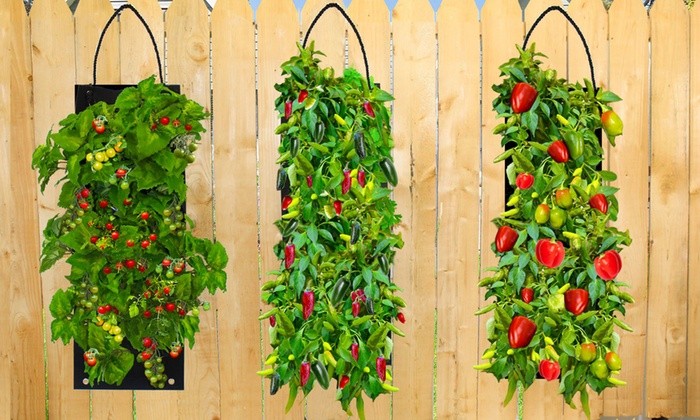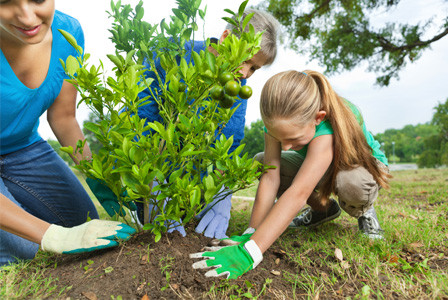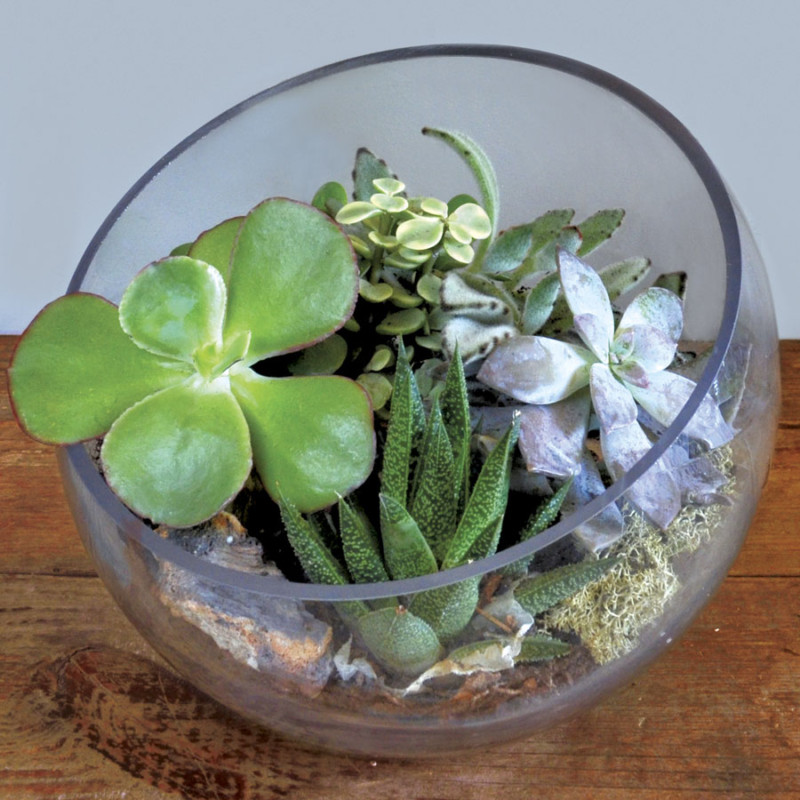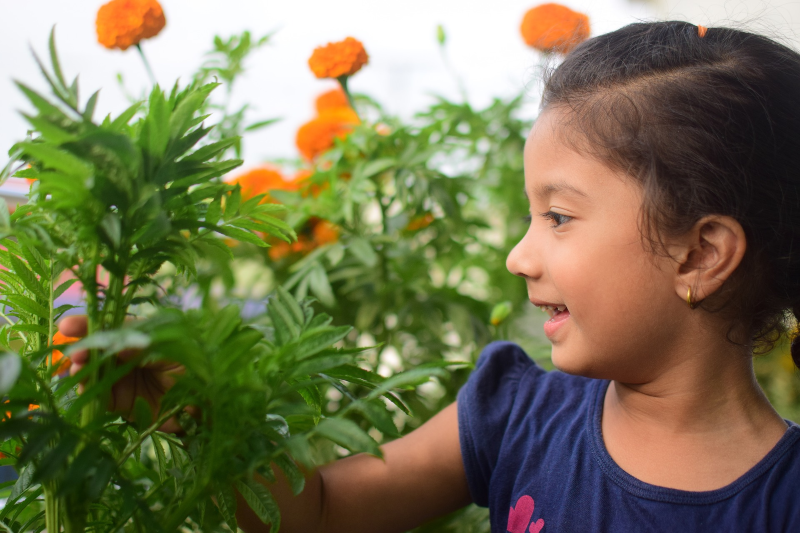Summer is a great time to spend time outdoors in the garden with the family. Getting children involved in some simple yard projects is a great way to teach them about growing plants and vegetables and offers the opportunity for your child to understand, respect and enjoy nature’s benefits.
Here’s 3 great gardening projects you can do with your kids.
1Hanging Edible Plants

Hanging plants are so easy. It’s a great way to have some produce without the trestles and other upkeep. By hanging the plants and letting them grow upside down, the gravity lets it grow the way it needs to. While tomatoes are probably the most popular, you can also grow cucumbers, peppers, and other plants with this method. This is a fairly easy project to do. You can buy hanging baskets or other hanging planters or make your own at home with almost any plastic container.
Instructions:
- Starting with gallon-sized jugs, remove the labels, use a pair of scissors to carefully cut off the bottom, and have a fun painting project to make them prettier.
- Once they’re dry, make holes in the four sides about an inch down from what used to be the bottom and thread the twine through for hanging.
- From here, you can slip the seedling carefully through the nozzle of the jug so that the roots are in the jug and the stem and leaves are sticking out.
- Once positioned you can fill the rest of the jug with organic potting soil, hang, and then water them.
- Make sure to check on them frequently and make sure they have water. Because they are not in the soil, they will need more help staying hydrated.
Watch this video for more.
2Planting a Family Tree

Planting a family tree can be a really fun experience, as your child can watch the tree grow over time. You can plant a tree from a seedling or buy a small tree to plant together. Plant a tree with a child and you’re likely to also seed a fond memory that will grow into a deep connection with the tree as both child and tree mature. If you want trees that also help sustain you, there’s plenty of fruit trees that will grow well in the area like apples and pears. You’ll just need the tree, a shovel, and soil if you want to place some around the base of the tree. Many also use twine to help the tree stand better and grow straighter.
This project is a great one for the fall since upkeep will be less. The soil is warm enough for the roots to grow more into the ground, but not so cold that the ground freezes once winter hits. You should also check to make sure where all the underground utilities are like electric, cable, and gas lines by calling Dig Safe 811, so that you can avoid them.
Instructions:
- Pick an appropriate tree for your area. Many places have a list of suggested plants for the area available through the local county offices. For best results, you’ll want to choose an appropriate native species where possible. If you do not choose a native tree, make sure your chosen tree is hardy in your area. Also consider flowering time and color, if it fruits, and if it will need special pruning and care. You can also check with experienced garden center staff for more information on this.
- Pick a location, being mindful of the overhead and underground utilities
- Follow the tree planting instructions that are provided with the plant, but in most cases you’ll want to make a hole that is 2-3 times the width of the roots of the tree that you have and deep enough that you cover the roots, but not so deep that you cut off the roots from oxygen.
- You’ll then put the tree in the hole and begin putting back the native soil that you dug out to pack around the roots.
- From here, you can choose to stake and mulch the tree as appropriate, and then provide a little water to the tree.
- Don’t forget to name the tree! Creating a weatherproof sign for your tree is another great side project the family can do together. The sign can include the tree’s botanical name, its common name, and the name your family chose for it.
- Give Follow-Up Care. Keep your young tree well-watered during its first few seasons in the ground, but don’t overwater. The frequency of watering needed will depend on soil type, temperature, and rainfall, so check the soil moisture in both the roots and the backfill a couple times a week for the first month or two; then weekly after that.
- Every year, gather the family and take a picture around the tree. Collect the photos together in an album. As the years pass you’ll create a wonderful keepsake to pass down, a true family tree.
3Build a Terrarium

Terrariums have grown in popularity as an easy way to add a little greenery inside the house. A terrarium is a miniature garden grown inside a glass or plastic container. In most cases, it’s low maintenance and good starter project for introducing kids to gardening. For this you’ll need a good sized container, small gravel, potting soil, plants that will grow well indoors, and any decoration you may want to add.
Instructions:
- Find an appropriate container. Glass jars, fish bowls and tanks, clear plastic bottles and food containers can all make fine terrariums. Just make sure there is enough room to reach your hand into your container for planting and maintenance. Depending on the plants that you choose, you can have an open or closed terrarium. For instance, if you want succulents, it can be closed. Herbs and other plants may need an open terrarium.
- Clean the container using soapy water and rinse well. Dry completely.
- Cover the bottom of the container with ½ inch (for small containers) to 1-1/2 inch (for large containers) of pea gravel for drainage. This mimics the bedrock found under our soils and allows access water to drain from the soil.
- Next fill the container to approximately one-third to one-half full with moist, sterilized potting mix.
- Next add your plants. You need to look for plants that are small, slow-growing, and perform well in humid environments. Many choose succulents, but you can also choose herbs or other plants like African violet, artillery fern, false aralia, jade plant, miniature peperomia, nerve plant, oxalis, pink polka dot plant, prayer plant, small ferns, small peace lilies, small philodendrons, spider plant, strawberry begonia, and Swedish ivy.
- Once the plants are placed in the soil, and there’s enough water to keep them growing, you can add in creative and decorative objects to make your own landscape scene. For instance you may want to add decorative rocks, small animal figurines, small bridges or mirrors to look like mini ponds.
- Place the terrarium in a windowsill with indirect lighting or under grow lights. Do not place it in strong direct sunlight or water will evaporate too quickly and plants may scorch.
- Observe your terrarium closely for the first few days to make sure you have the proper moisture level. The soil needs to be moist, but not so that the plants are downed.
- Check on your terrarium periodically. Prune or remove plants with excessive growth. You want to avoid plant leaves touching the sides of the container as much as possible to prevent constant water sitting on the foliage. Also check on the moisture levels as some water may be lost over time.
Gardening with your kids can be a fun and memorable experience for them for years to come. These are sure to create lasting ones while also giving back to you in useful ways.
This article is brought to you by Franklin Rental, offering all types of gardening equipment and tools for rent for as little as a few hours up to a month. Learn more here.
Franklin Rental is located at 1516 Columbia Ave, Franklin TN 37064.



















